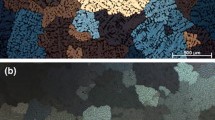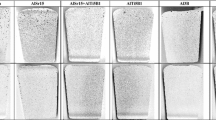Abstract
With expansion of integrated computational materials engineering, new mathematical models are required for the assessment of processes that traditionally were manually monitored on factory production floors. The Richards logistic function is used to describe the total amount of porosity in an as-cast aluminum alloy sample after treatment under near vacuum and atmospheric pressures. The acquired function constants were correlated to the different process parameters during solidification. It is found that the Richards logistic function describes the best formation of porosity in aluminum alloy melts. The maximum porosity (M P) and lowest porosity level (L P) constants are directly related to the highest and lowest porosity levels in the analyzed samples, while the rate (r) defines the increase of porosity with respect to an increase in dissolved hydrogen between the threshold and mass transfer limits. The Richards logistic function can be used instead of traditional low-order mathematical equations to predict threshold limit and amount of porosity in solidified aluminum alloys by assessing the hydrogen concentration in aluminum alloy melts.



Similar content being viewed by others
References
H. Liao, W. Song, Q. Wang, L. Zhao, and R. Fan, JOM 64, 22 (2012).
R. Wu, Z. Qu, D. Shu, J. Wang, and B. Sun, JOM 59 (1), 62 (2007).
D. Larsen, JOM 49 (8), 27 (1997).
P. Anyalebechi, Scripta Metall. Mater. 34, 1209 (1996).
W. laOrchan, M. Mulazimoglu, X. Chen, and J. Gruzleski, AFS Trans. 104, 565 (1995).
X. Chen, F. Klinkenberg, S. Engler, L. Heusler, and W. Schneider, JOM 46 (8), 34 (1994).
P. Hess, Light Met. 2, 837 (1974).
P. Crossley and L. Mondolfo, Mod. Casting 49, 53 (1966).
E. Whittenberger and F. Rhines, JOM 4, 409 (1952).
M. Krupinski, L. Dobrzanski, J. Sokolowski, W. Kasprzak, and G. Byczynski, Mater. Sci. Forum 539–543, 339 (2007).
A. Mitrasinovic (Master Thesis, University of Windsor, 2004).
A. Mitrasinovic, F.C. Robles Hernandez, M. Djurdjevic, and J. Sokolowski, Mater. Sci. Eng. A 428, 41 (2006).
F. Richards and J. Exper, Botany 10, 290 (1959).
C. Ransley and H. Neufeld, J. Inst. Met. 74, 228 (1948).
B. Deoras and V. Kondic, Foundry Trade J. 5, 361 (1956).
J.P. Anson and J.E. Gruzleski, AFS Trans. 107, 456 (1999).
A. Kirstine Frie, V. Potelov, M. Kingsley, and T. HaugTrends, ICES J. Mar. Sci. 60, 1018 (2003).
J. Yang, J. Zhang, Z. Wang, Q. Zhu, and W. Wang, Am. Soc. Plant Biol. 127, 315 (2005).
J. Dolezal, H. Ishii, V. Vetrova, A. Sumida, and T. Hara, Ann. Bot. 94, 333 (2004).
R. Wu, Z. Wang, W. Zhao, and J. Cheverud, Genetics 168, 2383 (2004).
A. Mitrašinović, R. D’Souza, and T. Utigard, J. Mater. Process. Tech. 212, 78 (2012).
A. Mitrašinović, R. D'Souza, T. Utigard and J.Z. Wen, Miner. Process. Extract. Metall. Rev. (2012). doi:10.1080/08827508.2012.684191.
S. Sand, D. von Rosen, K. Victorin, and A.F. Filipsson, Toxicol. Sci. 90, 241 (2006).
Author information
Authors and Affiliations
Corresponding author
Rights and permissions
About this article
Cite this article
Mitrašinović, A.M., D’Souza, R. Hydrogen Effervescence from Aluminum Alloy Melts. JOM 64, 1448–1452 (2012). https://doi.org/10.1007/s11837-012-0472-4
Received:
Accepted:
Published:
Issue Date:
DOI: https://doi.org/10.1007/s11837-012-0472-4




